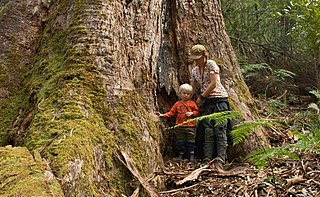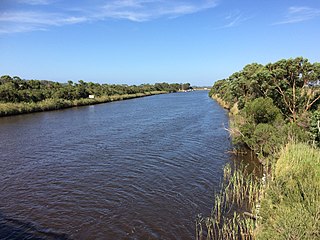The Diyari, alternatively transcribed as Dieri, is an Indigenous Australian group and language of the South Australian desert originating in and around the delta of Cooper Creek to the east of Lake Eyre.
The Boon wurrung, commonly written Bunurong, and also Boonurrong, Boonoorong, Boonoor-ong, Boon-oor-rong, Boongerong, Bunwurung or Bunwurru, are Indigenous Australians of the Kulin nation, who occupy South-Central Victoria, Australia. Before British settlement, they lived as all people of the Kulin nation lived, sustainably on the land, predominantly as hunters and gatherers, for tens of thousands of years. They were referred to by Europeans as the Western Port or Port Philip tribe and were in alliance with other tribes in the Kulin nation, having particularly strong ties to the Wurundjeri people.

The Gunai language is an Australian aboriginal dialect cluster of the Gunai people in Gippsland in south-east Victoria. Bidhawal (Birrdhawal) was either a divergent dialect or a closely related language.
The Mirning, also known as the Ngandatha, are an Indigenous Australian people whose traditional lands lay on the coastal region of the Great Australian Bight extending from Western Australia into south-west South Australia.
The Erawirung. otherwise known as Yirau, were an Indigenous Australian people group whose traditional territory was located in what is today South Australia.
The Djilamatang were thought to be a distinct Indigenous Australian people of the state of Victoria, Australia. This has recently been questioned by Ian Clark.
The Dhudhuroa people were an Indigenous Australian people of North-eastern Victoria, in the state of Victoria, Australia.
The Brabiralung were an Indigenous Australian people, one of the five tribes of Gippsland, in the state of Victoria, Australia, and belonged to a wider regional grouping known as the Kurnai.
The Braiakaulung were an indigenous Australian people of the state of Victoria. They were recognized by Norman Tindale as an independent tribal grouping. They constituted one of the 5 tribes of the GunaiKurnai nation.
The Brataualung were an Indigenous Australian people, one of the five tribes of Gippsland, in the state of Victoria, Australia, and part of a wider regional grouping known as the Kurnai.
The Tatungalung were an indigenous Australian tribe of the state of Victoria. They are often, together with the Bratauolung, Braiakaulung, Brabiralung and Krauatungalung classified as belonging to one nation, the Gunai/Kurnai, though this typology has been thought, by Norman Tindale for one, to be an artificial construct.
The Jupagalk were an indigenous Australian people of the State of Victoria. They may have been a Wergaia clan.
The Jaitmatang, also spelled Yaithmathang, were an indigenous Australian people of the State of Victoria.
The Marditjali were an Indigenous Australian people, a small tribe, distinct from the Jaadwa whose lands extended from the state of Victoria to South Australia.
The Ngalea or Ngalia were an indigenous Australian people of the Western Desert cultural bloc resident in land extending from Western Australia to the west of South Australia. They are not to be confused with the Ngalia of the Northern Territory.
The Kokatha, also known as the Kokatha Mula, are an indigenous Australian people of the state of South Australia. They speak the Kokatha language, close to or a dialect of the Western Desert language.
The Antakirinja, otherwise spelt Antakarinya, and alternatively spoken of as the Ngonde, are an indigenous Australian people of South Australia.
The Kuyani are an indigenous Australian people of the state of South Australia who speak or spoke the Kuyani language.
The Nauo (Nawu) were an indigenous Australian people of South Australia who spoke the Nauo language. They became extinct by the end of the nineteenth century.






